Investigation of the Influence of Cutting Parameters on Conical Pick Cutting Performance and Rock Damage
Abstract
:1. Introduction
2. Methods and Simulation Model
2.1. Cutting Force Model of a Conical Pick Cutting Rock
2.2. The Rock Damage Statistical Algorithm
2.3. Constitutive Model of Rock Material
3. Modeling and Verification
3.1. Numerical Simulation Model
3.2. Verification and Modification
3.3. Establishing the Rock Damage Statistical Model
3.4. Establishing the Statistical Model of Rock and Modifications
4. Results and Discussion
4.1. The Effect of Cutting Angle on Cutting Performance and Rock Damage
4.2. The Effect of Cutting Depth on Cutting Performance and Rock Damage
4.3. The Influence of Cutting Speed on Cutting Performance and Rock Damage
4.4. The Influence of the Distance between Double Conical Picks on Cutting Performance and Rock Damage
5. Conclusions
Author Contributions
Funding
Data Availability Statement
Conflicts of Interest
References
- Evans, I. A theory of the cutting force for point-attack picks. Int. J. Min. Eng. 1984, 2, 63–71. [Google Scholar] [CrossRef]
- Goktan, R.; Gunes, N. A semi-empirical approach to cutting force prediction for point attack picks. J. South Afr. Inst. Min. Metall. 2005, 105, 257–263. [Google Scholar]
- Shao, W. A Study of Rock Cutting with Point Attack Picks; The University of Queensland: St Lucia, QLD, Australia, 2016. [Google Scholar]
- Shao, W.; Li, X.; Sun, Y.; Huang, H. Parametric study of rock cutting with SMART∗CUT picks. Tunn. Undergr. Space Technol. 2017, 62, 134–144. [Google Scholar] [CrossRef]
- Copur, H.; Bilgin, N.; Balci, C.; Tumac, D.; Avunduk, E. Effects of different cutting patterns and experimental conditions on the performance of a conical drag tool. Rock Mech. Rock Eng. 2017, 50, 1585–1609. [Google Scholar] [CrossRef]
- Hekimoglu, O.; Ozdemir, L. Effect of angle of wrap on cutting performance of drum shearers and continuous miners. Min. Technol. 2013, 113, 118–122. [Google Scholar] [CrossRef]
- Kotwica, K.; Malkowski, P. Methods of Mechanical Mining of Compact-Rock—A Comparison of Efficiency and Energy Consumption. Energies 2019, 12, 3562. [Google Scholar] [CrossRef] [Green Version]
- Saurabh, D.; Somnath, C.; Sergej, H. Critical Damage Analysis of WC-Co Tip of Conical Pick due to Coal Excavation in Mines. Adv. Mater. Sci. Eng. 2015, 2015, 292046. [Google Scholar]
- Saurabh, D. On the Critical Assessment into Damage Behavior of a WC–Co Hard Metal Alloy Used in the Form of Rock Drill Bits. J. Fail. Anal. Prev. 2019, 19, 461–470. [Google Scholar]
- Saurabh, D.; Someath, C. Critical Analysis of Wear Mechanisms in Cemented Carbide. J. Mater. Eng. Perform. 2015, 24, 2628–2636. [Google Scholar]
- Saurabh, D.; Somnath, C.; Sergej, H. Wear Assessment of Conical Pick used in Coal Cutting Operation. Rock Mech. Rock Eng. 2015, 48, 2129–2139. [Google Scholar]
- Krauze, K.; Mucha, K.; Wydro, T.; Pieczora, E. Functional and Operational Requirements to Be Fulfilled by Conical Picks Regarding Their Wear Rate and Investment Costs. Energies 2021, 14, 3696. [Google Scholar] [CrossRef]
- Krauze, K.; Mucha, K.; Wydro, T.; Klempka, R. Assessment of the Structure of Cutting Heads with Regard to the Mining Machine Load Using Proprietary Software. Energies 2022, 15, 6886. [Google Scholar] [CrossRef]
- Mucha, K.; Augustyn-Nadzieja, J.; Szczotok, A.; Krauze, K. An Improved Procedure for the Quality Control of Sintered Carbide Tips for Mining Applications, Based on Quantitative Image Analysis of the Microstructure. Materials 2021, 14, 1236. [Google Scholar] [CrossRef] [PubMed]
- Deng, J.; Gu, D. On a statistical damage constitutive model for rock materials. Comput. Geosci. 2011, 37, 122–128. [Google Scholar] [CrossRef]
- Abouzar, V. An improved unified constitutive model for rock material and guidelines for its application in numerical modelling. Comput. Geotech. 2016, 80, 261–282. [Google Scholar]
- Huang, H.; Lecampion, B.; Detournay, E. Discrete element modeling of tool-rock interaction I: Rock cutting. Int. J. Numer. Anal. Methods Geomech. 2013, 37, 1913–1929. [Google Scholar] [CrossRef]
- Rojek, J. Discrete element modeling of rock cutting. Comput. Methods Mater. Sci. 2007, 7, 224–230. [Google Scholar]
- Jaime, M.; Zhou, Y.; Lin, J.; Gamwo, I.K. Finite element modeling of rock cutting and its fragmentation process. Int. J. Rock Mech. Min. Sci. 2015, 80, 137–146. [Google Scholar] [CrossRef] [Green Version]
- Menezes, P. Influence of cutter velocity, friction coefficient and rake angle on the formation of discontinuous rock fragments during rock cutting process. Int. J. Adv. Manuf. Technol. 2016, 90, 3811–3827. [Google Scholar] [CrossRef]
- Fourmeau, M.; Kane, A.; Hokka, M. Experimental and numerical study of drill bit drop tests on Kuru granite. Philos. Trans. 2017, 375, 20160176. [Google Scholar] [CrossRef] [Green Version]
- Zhou, Y.; Lin, J. Modeling the ductile–brittle failure mode transition in rock cutting. Eng. Fract. Mech. 2014, 127, 135–147. [Google Scholar] [CrossRef]
- Li, X.; Lv, Y.; Jiang, S. Effects of spiral line for pick arrangement on boom type roadheader cutting load. Int. J. Simul. Model. IJSIMM 2016, 15, 170–180. [Google Scholar] [CrossRef]
- Zhu, L.; Wei, T.; Liu, B.; Yu, T. Simulation analysis of rock braking mechanism of tunnel boring achine. Teh. Vjesn. 2016, 23, 169342. [Google Scholar]
- Roxborough, F.; Liu, Z. Theoretical considerations on pick shape in rock and coal cutting. In Proceedings of the sixth underground operator’s conference, Kalgoorlie, WA, Australia, 13–14 November 1995; Golosinski, T.S., Ed.; pp. 189–193. [Google Scholar]
- Zhang, Y. Design and Implementation of License Plate Image Recognition Based on MATLAB. Inf. Commulation 2019, 11, 79–81. [Google Scholar]
- Wang, W.; Ding, J.; Wang, P.; Lu, Z. Research on the image recognition of target sheet with MATLAB. Computer Era 2016, 11, 17–20+24. [Google Scholar]
- Liu, K. The Study on Image Recognition of Coal ang Gangue Boiundary Signatures Based on the Fractional Calculus; China University of Mining and Technology: Beijing, China, 2018. [Google Scholar]
- Zeng, Q.; Wang, Z.; Lu, Z.; Wan, L.; Liu, Z.; Zhang, X. Research on cutting performance and fatigue life of conical pick in cutting rock process. Sci. Prog. 2021, 104, 1–29. [Google Scholar] [CrossRef]
- Lu, Z.; Wan, L.; Zeng, Q.; Zhang, X.; Gao, K. Numerical Simulation of Fragment Separation during Rock Cutting Using a 3D Dynamic Finite Element Analysis Code. Adv. Mater. Sci. Eng. 2017, 2017, 3024918. [Google Scholar] [CrossRef]
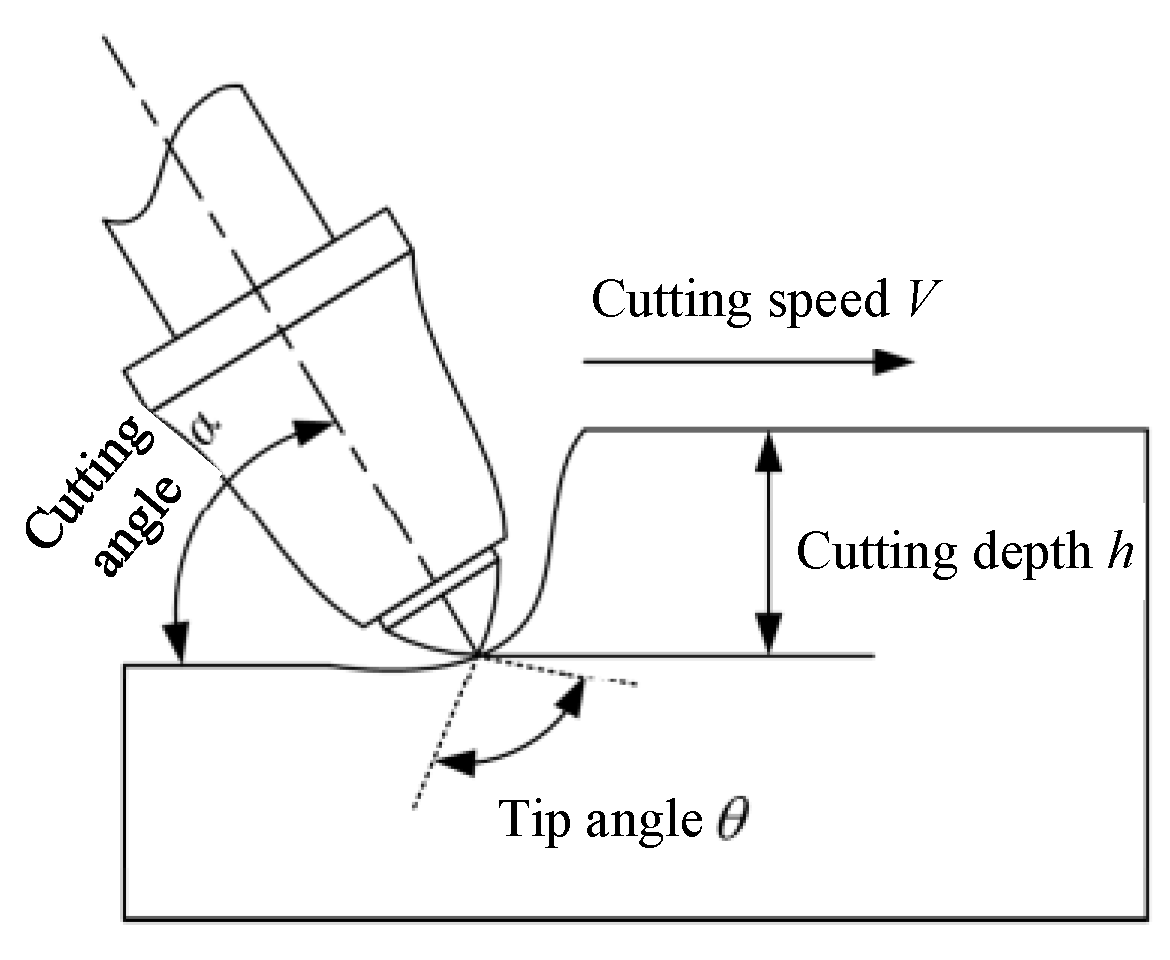

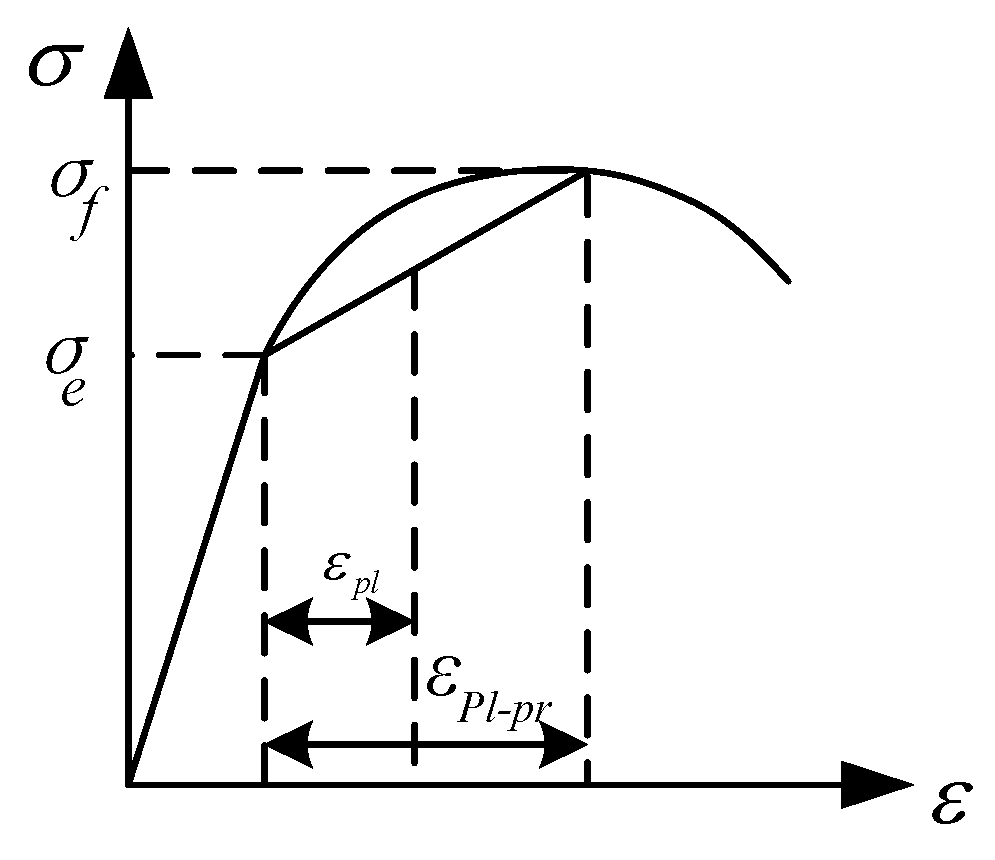
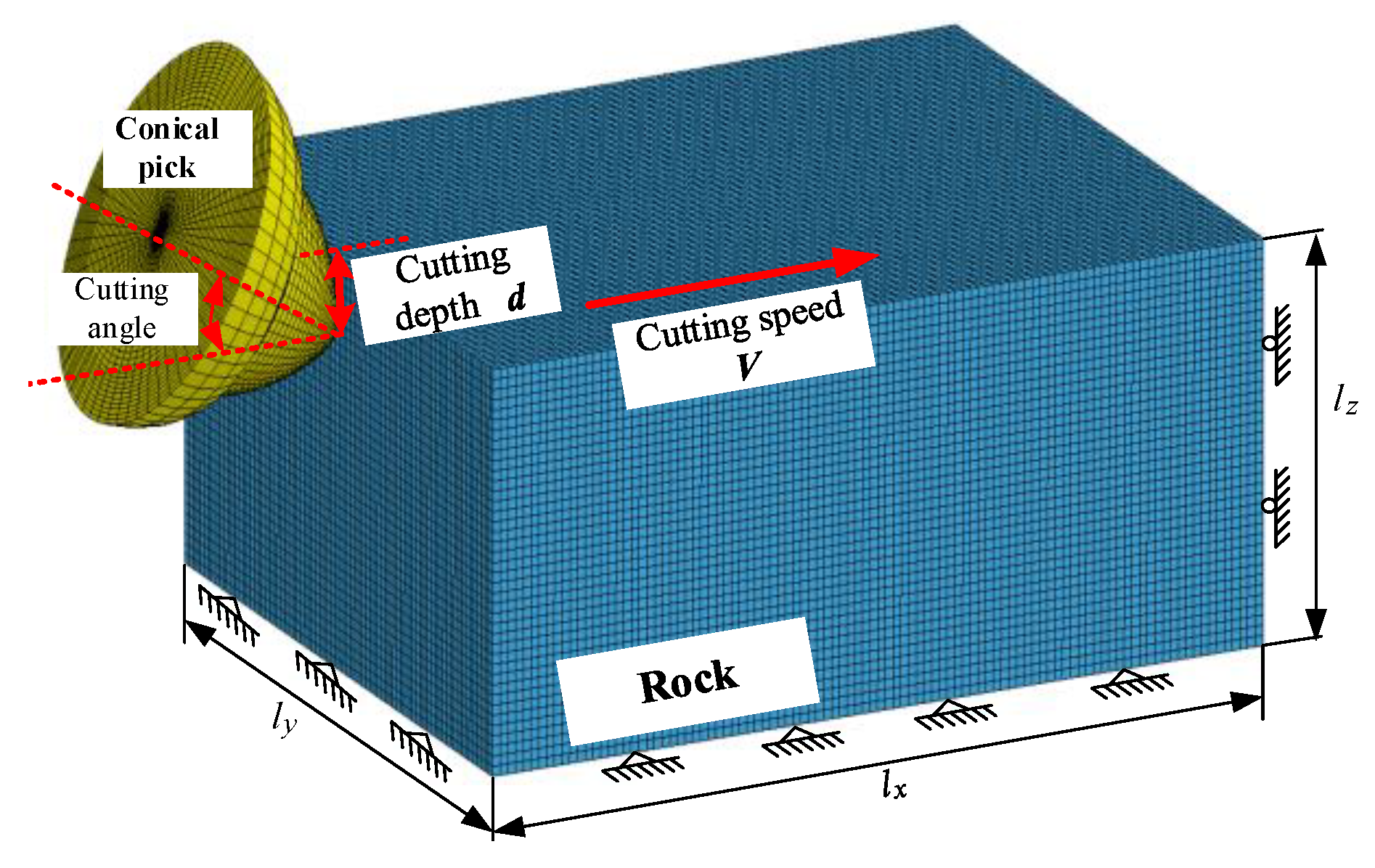
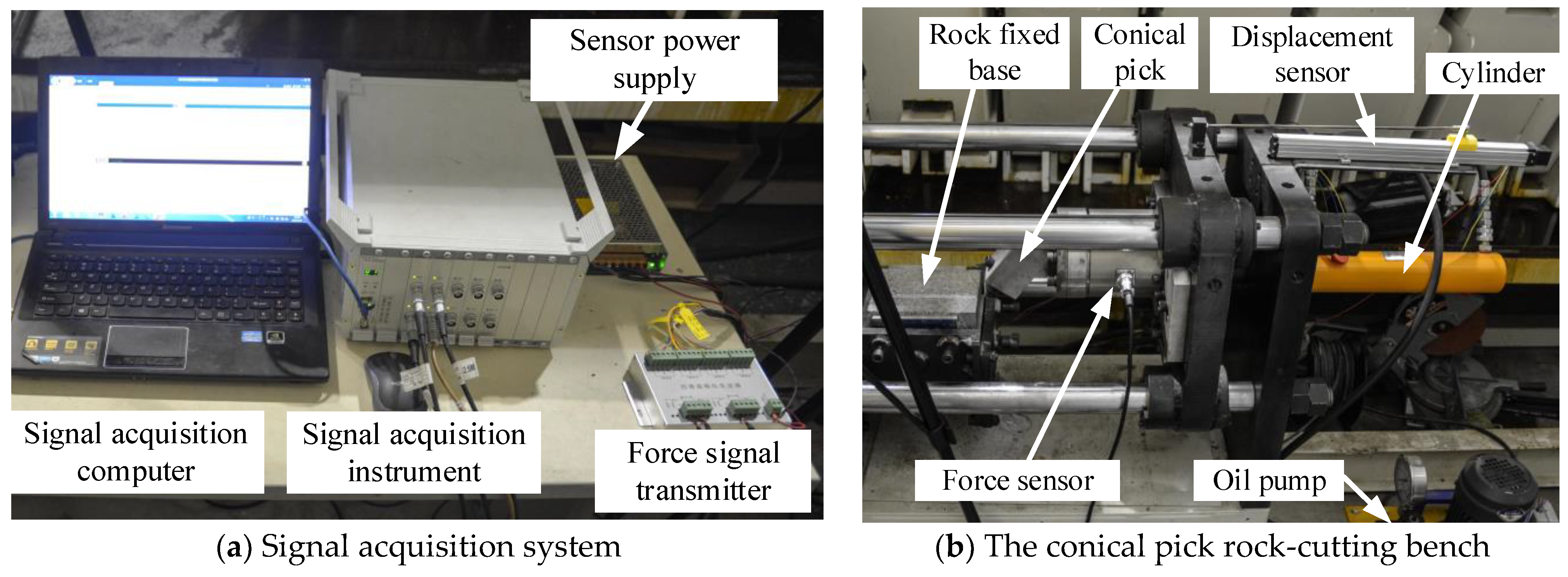
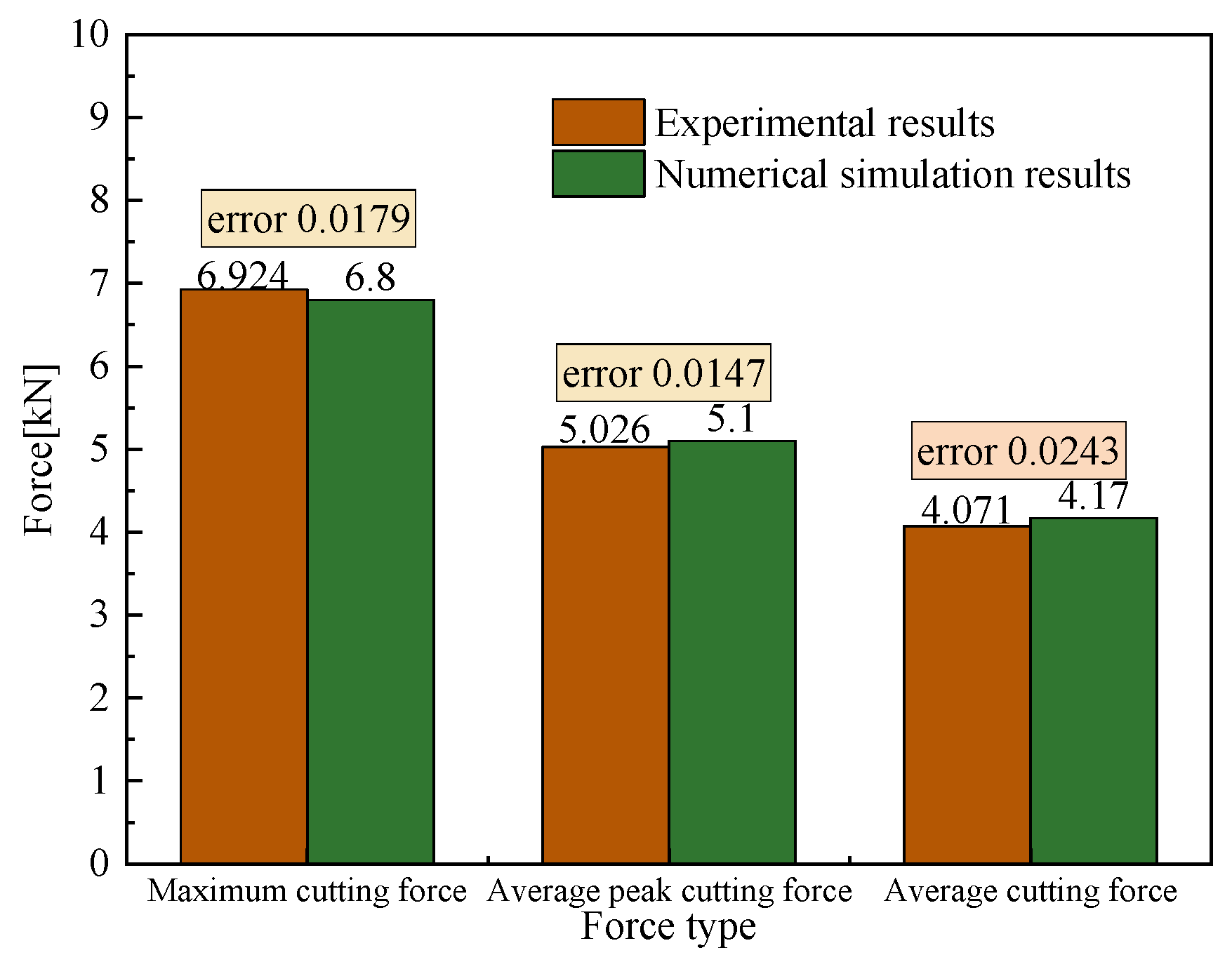
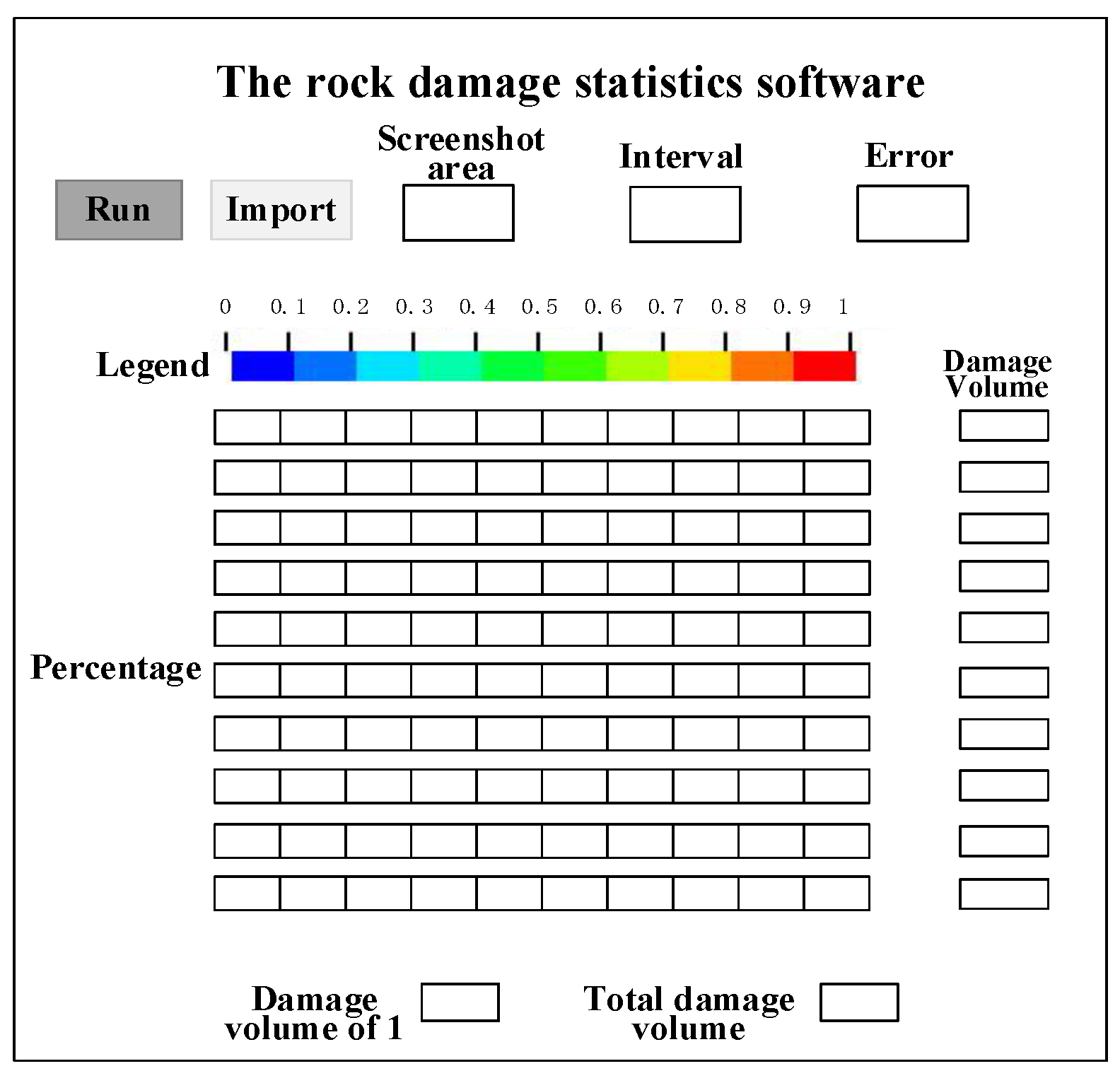

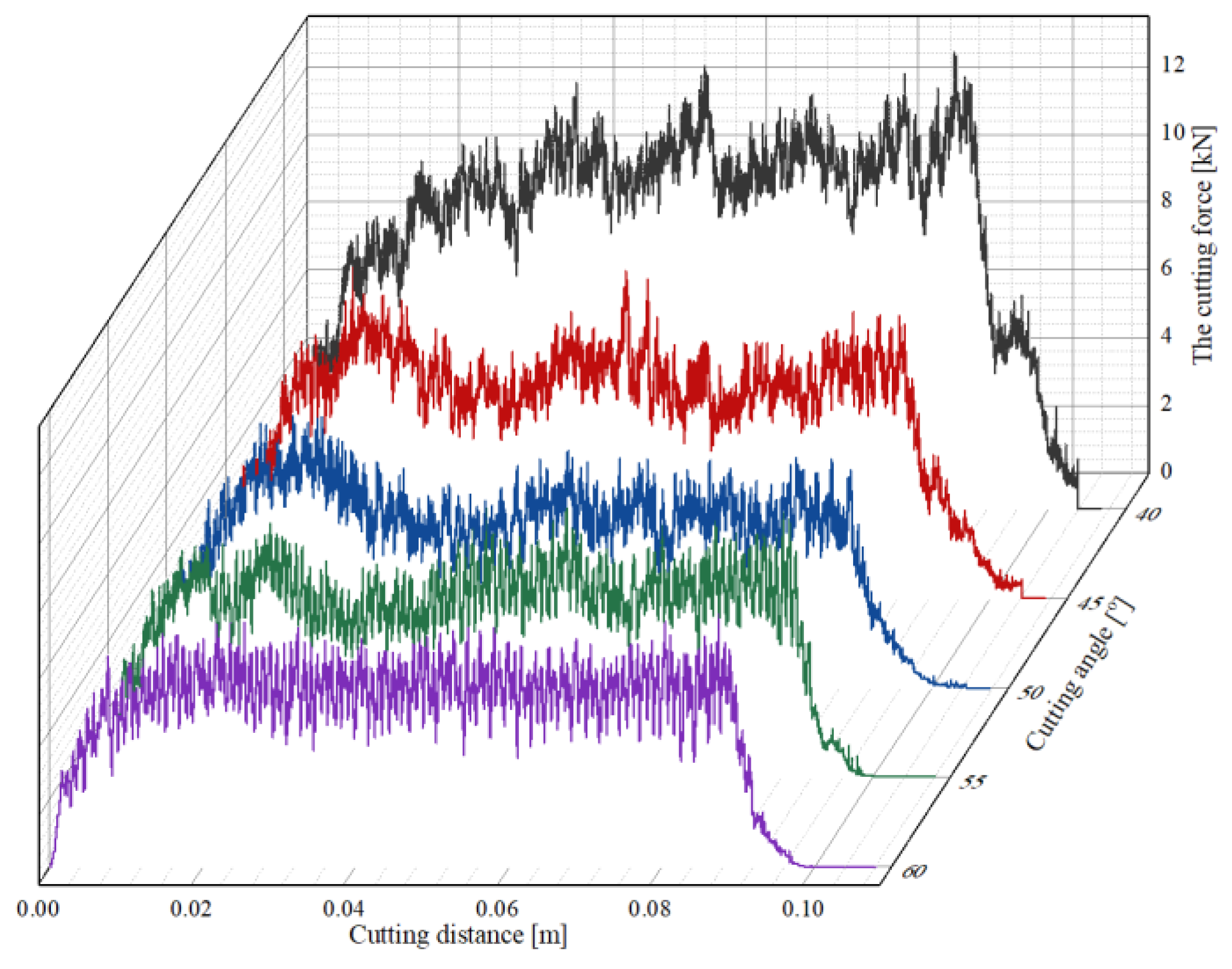


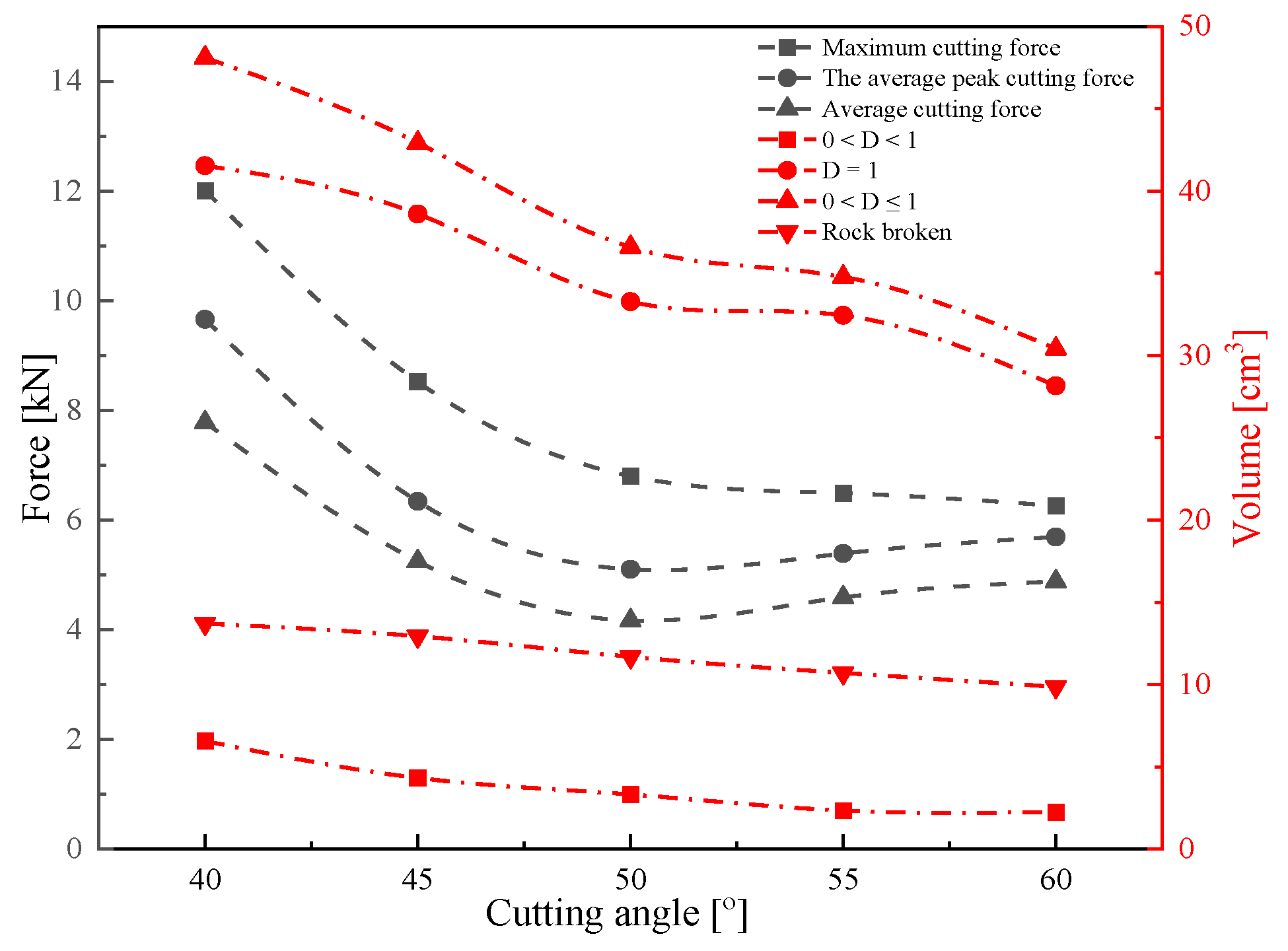
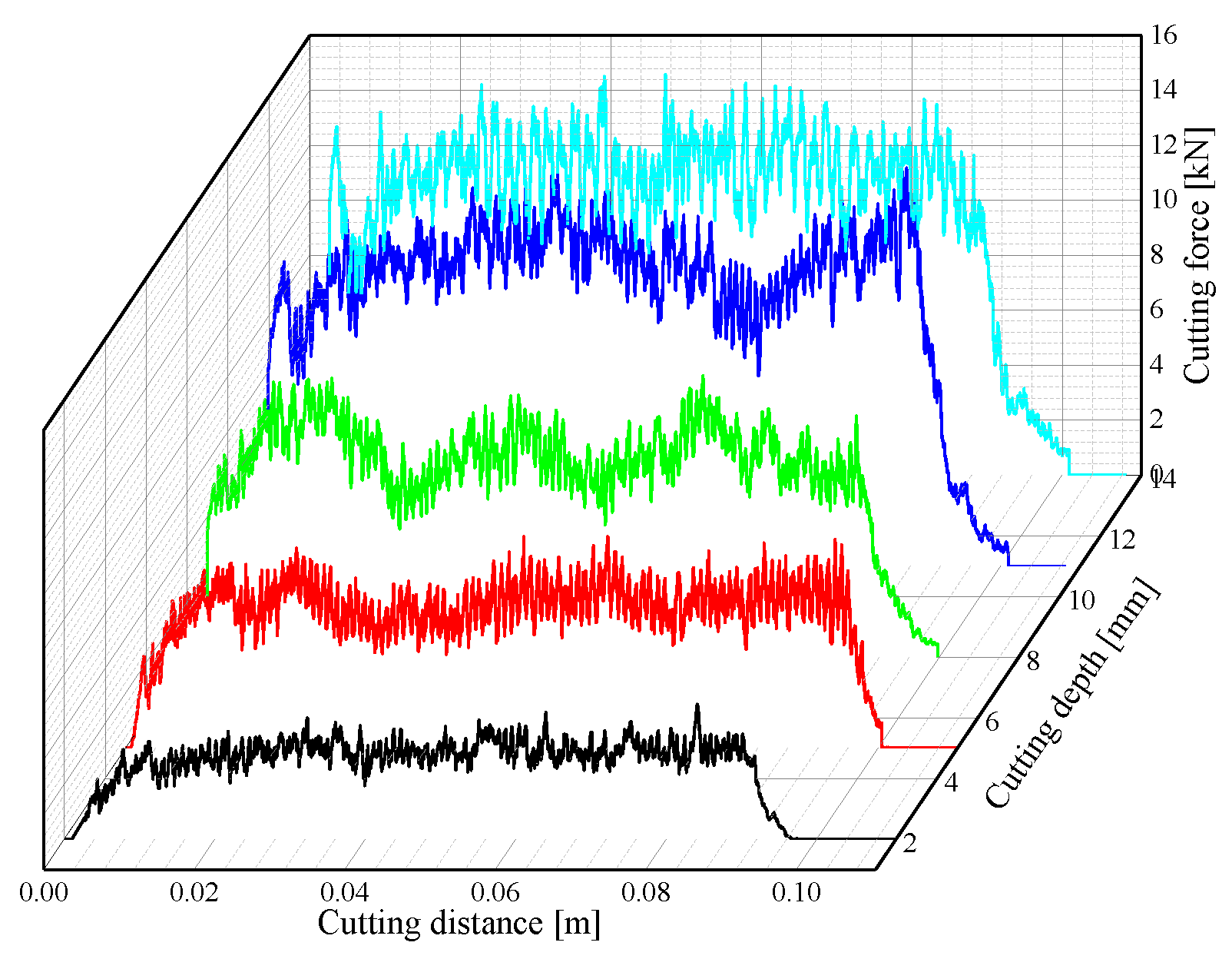




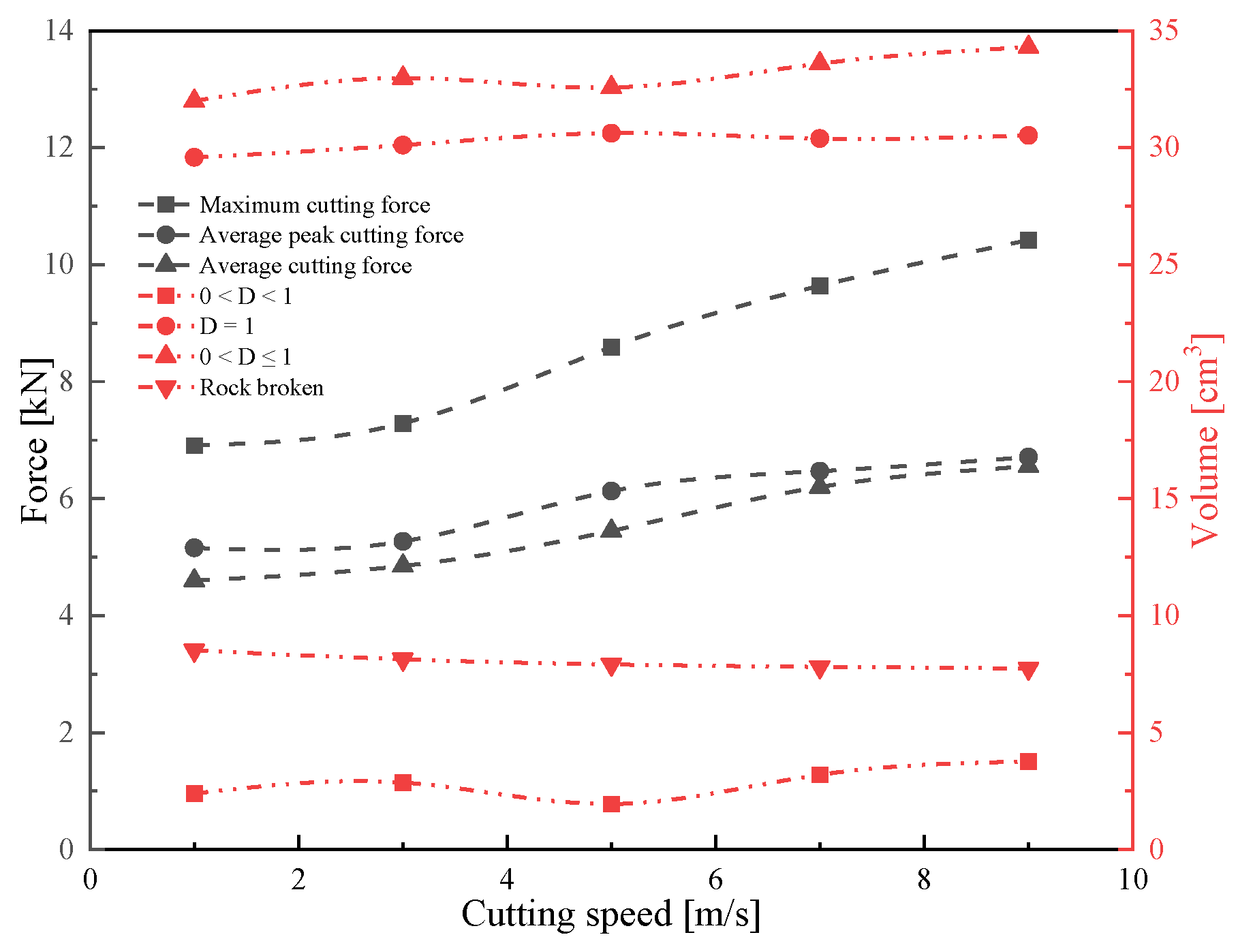
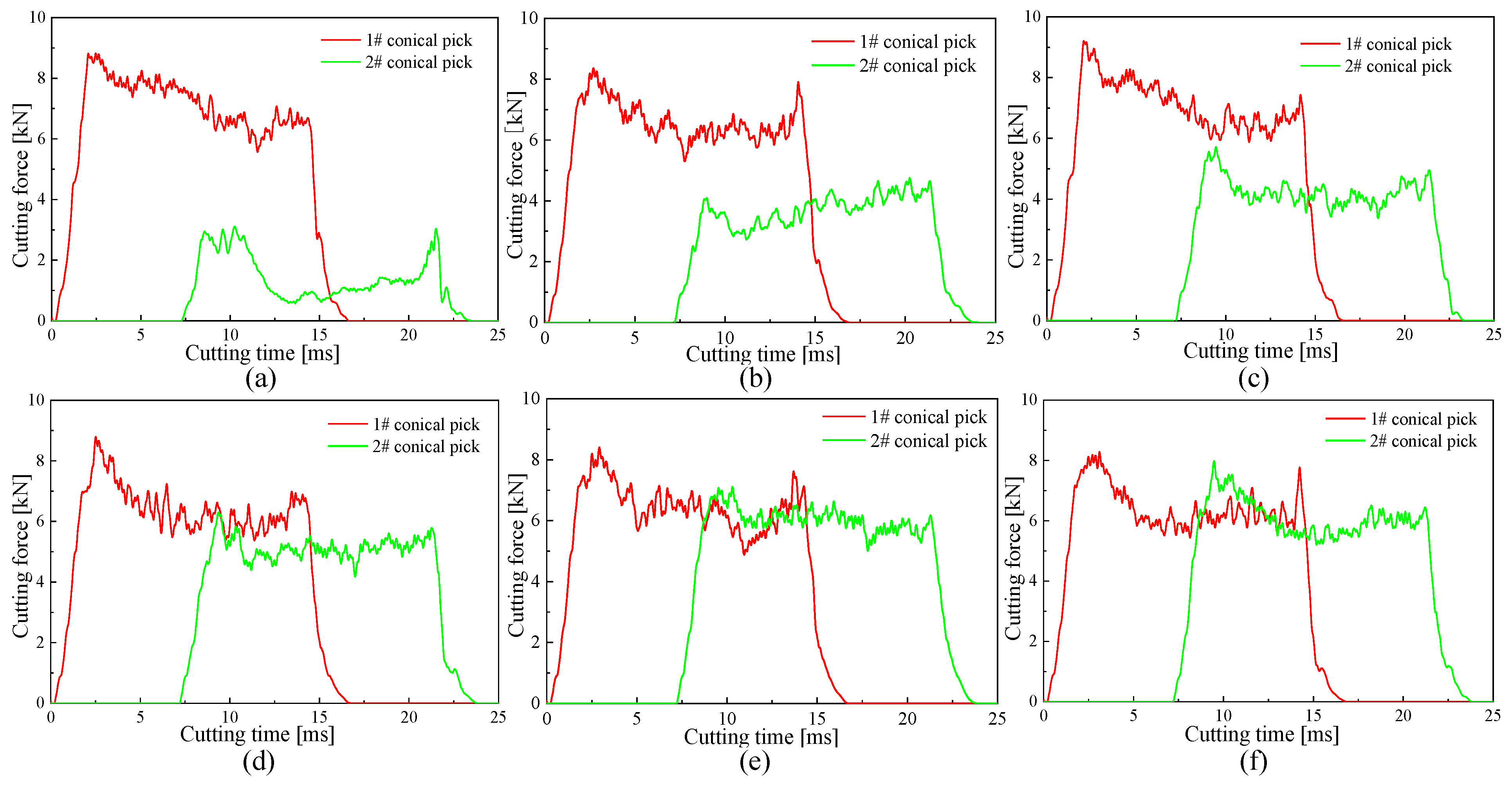

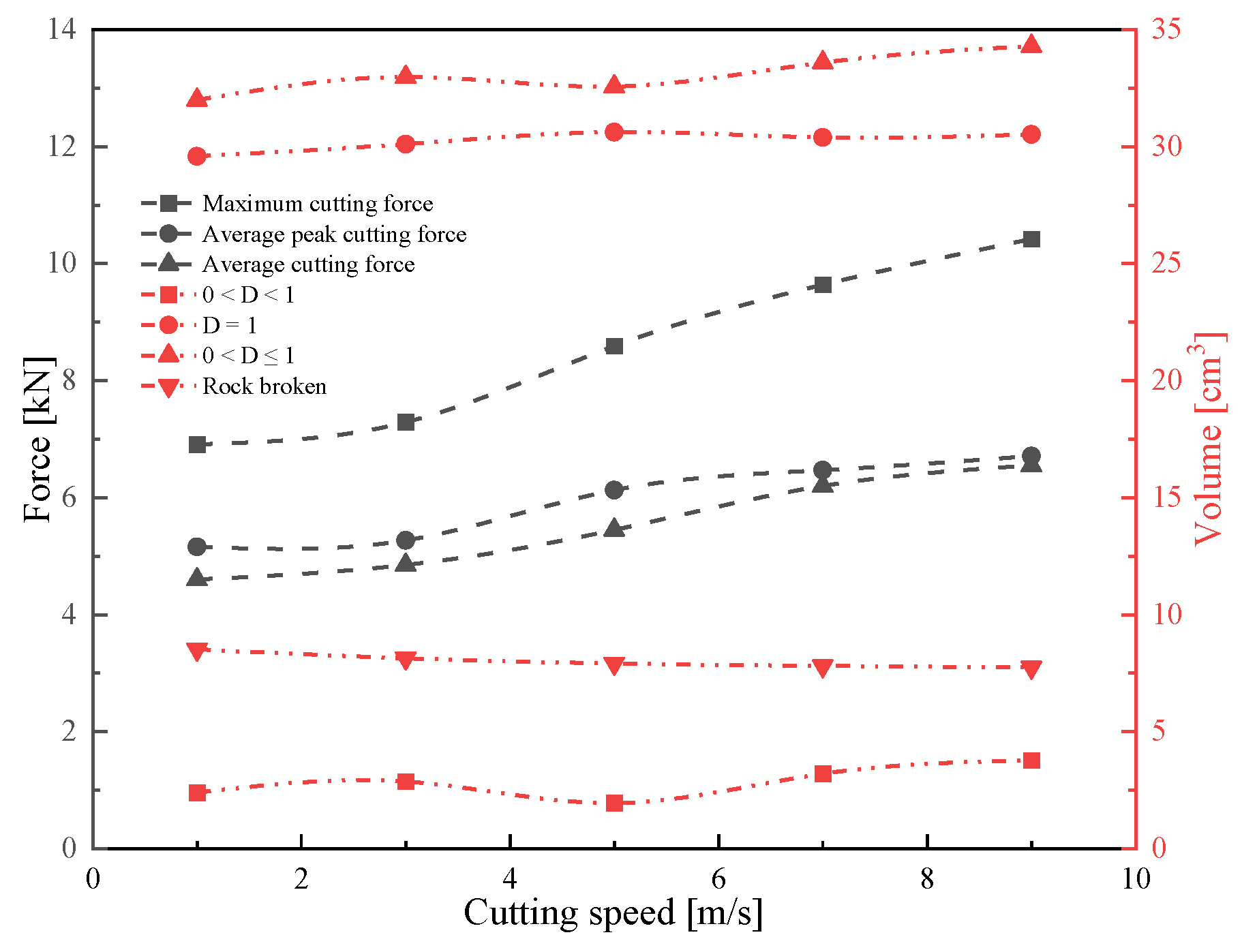
| Parameters | Compressive Strength (MPa) | Tensile Strength (MPa) | Density (kg/m3) | Poisson’s Ratio |
|---|---|---|---|---|
| Value | 141.20 | 6.67 | 2564.76 | 0.209 |
| Picture | The Proportion of Each Color in the Whole Picture | |||||||
|---|---|---|---|---|---|---|---|---|
| Picture a | 0.0403 | 0.0404 | 0.0403 | 0.0405 | 0.0404 | 0 | 0 | 0 |
| Picture b | 0.1016 | 0.1014 | 0.1013 | 0.1006 | 0.1010 | 0 | 0 | 0 |
| Picture c | 0.0041 | 0.0051 | 0.0073 | 0.0061 | 0.0069 | 0.0118 | 0.1539 | 0.2112 |
Publisher’s Note: MDPI stays neutral with regard to jurisdictional claims in published maps and institutional affiliations. |
© 2022 by the authors. Licensee MDPI, Basel, Switzerland. This article is an open access article distributed under the terms and conditions of the Creative Commons Attribution (CC BY) license (https://creativecommons.org/licenses/by/4.0/).
Share and Cite
Wang, Z.; Zeng, Q.; Wan, L.; Lu, Z.; Wang, H. Investigation of the Influence of Cutting Parameters on Conical Pick Cutting Performance and Rock Damage. Machines 2022, 10, 1034. https://doi.org/10.3390/machines10111034
Wang Z, Zeng Q, Wan L, Lu Z, Wang H. Investigation of the Influence of Cutting Parameters on Conical Pick Cutting Performance and Rock Damage. Machines. 2022; 10(11):1034. https://doi.org/10.3390/machines10111034
Chicago/Turabian StyleWang, Zhiwen, Qingliang Zeng, Lirong Wan, Zhenguo Lu, and Hongbin Wang. 2022. "Investigation of the Influence of Cutting Parameters on Conical Pick Cutting Performance and Rock Damage" Machines 10, no. 11: 1034. https://doi.org/10.3390/machines10111034





